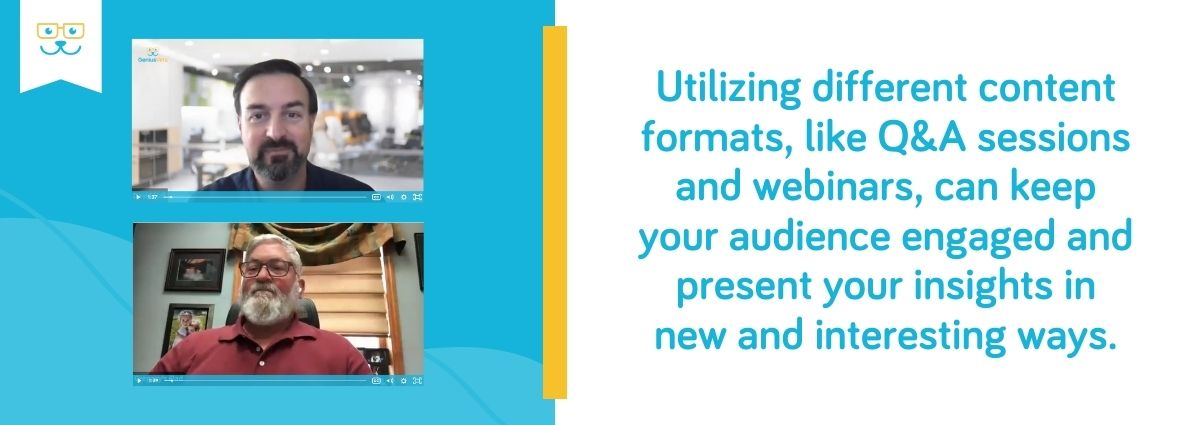Top Tips for Incorporating Veterinary Thought Leadership Into Your Organic Social Strategy
In today’s competitive market for veterinary information, it’s more important than ever for veterinarians and practice owners to rethink how they use their tools and platforms to showcase their expertise. One of the most effective ways to do this is to revamp your organic social media strategy and incorporate a tried and true conversation starter: thought leadership.
You might not realize it, but thought leadership is everywhere online. In this blog, we’ll walk you through the essentials of thought leadership, who qualifies as thought leaders, where it fits into your veterinary practice’s social media strategy, and how to get started. Let's dive in and unlock the potential of thought leadership for your practice!
What Is Thought Leadership?
Boosting your social media engagement and creating authority on certain topics probably sounds appealing. But if you’re new to the world of marketing and content, you may be asking, “What even is thought leadership? And how – and what – do I share?”

To start, let’s address the first question and get to know the in’s and out’s of who thought leaders are and what they do. At its core, thought leadership is the practice of leveraging the expertise, insights, and unique perspectives of your veterinary practice to position yourself as a trusted authority in the industry. Often, thought leaders will benefit from their status as recognized and trusted figures, but it’s crucial to remember that true and authentic thought leadership goes beyond self-promotion; at its heart, it’s about sharing new thoughts, diverse opinions, and valuable knowledge that can educate, inspire, and influence your audience.
Thought leadership content will differ from the standard blogs and educational videos your practice may be creating and sharing on social media already. While many blogs that DVMs write for educational purposes will focus on existing information and make it easily digestible for an audience, thought leadership aims to add value to existing industry conversations and introduce new or different – and sometimes controversial – thoughts and opinions that will make a difference in the way your audience thinks about or views a specific topic.
But thought leadership isn’t only limited to blogs. Thought leadership can really come in the form of any type of content, from research reports to audiograms, and everything in between.
Who Are Thought Leaders?
Thought leaders are generally thought of as individuals within an industry or space who are experts in their field and have strong opinions and original ideas, leading them to become a "go-to" source of trusted information and new ideas.

Thought leaders in the veterinary field can be anyone with significant expertise and influence, including:
- Veterinarians: Sharing insights from years of experience, clinical expertise, and innovative approaches to veterinary care.
- Veterinary Technicians and Nurses: Offering practical advice and behind-the-scenes perspectives on patient care.
- Veterinary Practice Owners and Managers: Providing guidance on running a successful practice, including management tips and business strategies.
- Researchers and Academics: Sharing the latest findings and advancements in veterinary science.
GeniusVets’ very own Dr. Michele Drake is a great example of a thought leader within the veterinary industry, who regularly shares her thoughts and opinions on business management and the world of veterinary medicine through speaking engagements, podcast and webinar appearances, and blog posts.
Resources like DVM360, LinkedIn, and the American Animal Hospitals Association (AAHA) content library are great places to start finding leading voices in the veterinary industry and learn more about what topics prominent thought leaders are talking about in industry forums.
You can even become a thought leader within the veterinary industry! All you need to do is start sharing your voice and letting the veterinary community know what you have to say.
Where Does Thought Leadership Fit Into a Social Media Strategy?
Now that you’re well acquainted with the world of veterinary thought leadership, let’s talk about the role it can play in your social media strategy.
Thought leadership can help take your social media presence to the next level by going beyond basic educational content and giving your audience new perspectives and an inside look at your approach to veterinary medicine and animal health care. This can strengthen your personal relationship with existing clients and other professionals, while also helping you tap into new audiences that are looking for new or in-depth insights into certain veterinary or pet care topics.
Sharing veterinary thought leadership content on your social media channels can also create new opportunities for your community to engage with you and participate in discussions on various topics. By responding to comments and addressing questions posed on your thought leadership content, you create a two-way dialogue that strengthens your relationship with your audience. This interaction not only humanizes your brand but also reinforces your role as a trusted advisor and go-to source of information. As a bonus, encouraging followers to react to your thoughts and opinions, and share their experiences or ask questions can lead to meaningful conversations that further establish your authority.
How to Get Started
Find Your Focus
When first experimenting with leveraging thought leadership content in your social strategy, identifying a clear focus for your content is essential. As a veterinary professional, you’ll want to base your focus on what sets you apart in the field or what areas of veterinary practice you are most well-versed and passionate about. Think, is it your expertise in a particular type of pet care, such as exotic animals or advanced surgical procedures, that sets you apart? Maybe you have a unique approach to preventive care or a strong emphasis on holistic treatments to create better patient outcomes. Use your unique expertise and opinions on these facets of veterinary medicine to your advantage and make your voice heard in the community!
Understanding your strengths and areas of specialty helps you define your niche, making your content more targeted and impactful. This focused approach ensures that your content resonates deeply with your audience, addressing their specific needs and concerns. Regularly reassess your focus to adapt to changing trends and keep yourself as a relevant and trusted voice in your field.
Choose or Develop Thought Leadership Content
The beauty of sharing thought leadership on social media is that you can choose to create your own content, share content from other veterinary thought leaders, or do a combination of both.
If you want to start contributing your voice to industry knowledge, you can start off by brainstorming topics that align with your focus and will be of interest to your audience. Consider creating content around common pet health issues or innovative treatments, where you can really highlight your expertise and add value to existing conversations. Mix up your formats to keep the audience engaged – use blog posts, videos, infographics, and live Q&A sessions.

While creating your own thought leadership content and getting your voice out in the community is always encouraged, sometimes there aren’t enough hours in the day to create content while also seeing patients or managing a practice. In those cases, you can seek out thought leadership from colleagues, industry leaders, or other trusted veterinary professionals, and share their thoughts on trending or important topics. Just be sure to thoroughly vet any articles or thought leaders before you share them to make sure their thoughts, opinions, and actions align with your practice’s values and ethics.
Pro tip: When you’re sharing thought leadership from other individuals outside of your practice, you can always add your voice in the post copy and give readers insights into whether or not you agree with it and why. This can spark new conversations and show your community that you’re tapped into what is happening throughout the industry. And don’t forget to tag any thought leaders whose content you share!
Select the Right Channels for Your Thought Leadership Goals
As we already discussed, thought leadership can serve different purposes and target different audiences. In order to maximize the impact of your thought leadership content, you’ll want to strategically plan where you post certain content pieces to ensure they’re reaching the appropriate audience. For example, if you have strong thoughts or valuable insights on a new surgical advancement and create a short video outlining why you think every veterinarian needs to be using it, professional platforms like LinkedIn will likely help you reach the veterinary community more effectively than Instagram or Twitter.
On the other hand, let’s say you’re an expert in dog nutrition and want to warn pet owners about the potential dangers of a trendy new pet diet that’s all over social media. Posting your thoughts and opinions on platforms where you have connections with pet owner communities, like Facebook, will be far more beneficial. You can even go beyond simply posting to your practice’s company social media pages and share content in community groups and online forums.
Understanding what your goals are and what audiences you want to reach will help you better define your organic thought leadership strategy and make more effective decisions on where to share content to reach the right readers or viewers.
Stay Up to Date and Check in With Your Audience Often
Like most other industries, the veterinary field is constantly evolving, with new research, treatments, and technologies emerging regularly. To maintain your status as a respected and relevant thought leader, it’s crucial to stay informed about the latest developments in your area of expertise. Follow industry news, attend conferences, and engage in continuous education to stay up to date with the latest happenings in the field, and don’t be afraid to be the first person to speak up about new thoughts or ideas.
In addition to staying on top of industry changes and trends, you’ll also want to stay on top of how your content is being received by your audience. Using the analytics capabilities built into each social media platform, you can gauge how your audience is responding to the thoughts and opinions you’re sharing and adjust your strategy accordingly to ensure continued growth and engagement.
If you're looking to shake things up with your social media strategy and utilize more industry best practices like this, get in touch with the GeniusVets team to learn more about our social media services.

